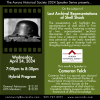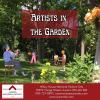Adair, Elsie (2014) Transcript
October 26, 2014
Transcription: Erika Mazanik interviewing Elsie Adair
Erika: My name is Erika Mazanik and I am here interviewing Elsie Adair at Hollandview Trail Retirement Community on October 26th 2014 for the Lets Talk Oral History Aurora Project. Hi Elsie how are you?
Elsie: I’m fine thank you! How are you?
Erika: Good thank you! So we were speaking about when you moved here, first initially before moving here, you started teaching in 1958 at George Street School. Would you like to tell us about that?
Elsie: Yes I had taught before then. Before coming to Aurora to teach. Well George Street School was the first new school to be built in Aurora. I’m talking in the public school system and not the Catholic. I don’t know about the other systems, maybe they made schools before this, but George Street was desperately needed here because Well Street was overflowing and while the new school was in process of being built they still had classes, a few classes that were running at the old church school which is now a cultural center. So in March that year four classes and the kindergarten classes were ready for use so they moved from that church school quickly to the new school and then four more classrooms were to be ready by September and they weren’t quite ready but the children were and the teachers were. Four of us were hired for that time. Mary Gilbert, Eleanor Hickling, Griffa, and myself and the classrooms weren’t ready. So we were on split shifts for about 5 or 6 weeks until they were ready and then of course we moved in quickly.
Erika: And you said that you didn’t have furniture at first.
Elsie: Three of these classrooms furniture was delivered when the classroom was ready but for some reason my furniture didn’t arrive for another week or maybe two weeks. I have just forgotten how long. If I remember correctly I had 39 children and they brought in library tables with small kindergarten chairs in order to accommodate that many children.
Erika: And you also said that there were only two classrooms ready and you had to split shifts.
Elsie: Yeah
Erika: And you also brought up that your daughter went to school with you.
Elsie: Yeas because I was travelling a distance and it would have meant an extra-long day for someone else to take care of her and she’s good company and she could read already so she came to school with me and that was nice. Therefore she was able to go home with me. Because we were out of town at the time, they paid for Janice to come to Aurora and they paid for me to come to Aurora. Any anyways, it was $30 a month and we continued to pay that throughout he public school education but when she finished grade 8 and wanted to go to high school, here, it was a firm rule that nobody out of the town was allowed to come whether they paid or not. So we moved to Aurora and she attended Williams High School for her education.
Erika: So how was that move? Was it a big transition for you, or for your family or was it kind of natural?
Elsie: Well, it was interesting. It saved a lot of time for me, over an hour a day because it was somewhat over the half hour each way well that would be an hour morning and night then wouldn’t it? So that was very good. Winter roads were not the best. We had one huge hill, the sixth hill there that if you could get a run at it then you’d get up but if there were other cars sitting this way, it was tricky. One day I couldn’t get my car up the hill because of this and I parked well of the road and a school bus came along. We flagged down the school bus and got us both to Aurora and I made some phone calls to get home. So I had some adventures on the way, but it was nice to be settled in Aurora and not have that worry and concern about getting there.
Erika: yeah that must have made things easier.
Elsie: And we had Mr. George Billings who was the principal when I came. A marvellous person to begin my teaching career in Aurora with. We had some good principals after that too. He moved on to Regency Acres Public School. Now I’ll tell you a funny story.
Erika: Sure
Elsie: The next principal that we had yeah George Billings had stayed for one year and then moved on to Regency and the next principal stayed for two years and then he moved to Aurora Heights Public School. And then another man came and he stayed for eleven years. Then on his going away party, I don’t know how it happened but anyway, I was sad with his leaving, rest to him for his years of dedications to George Street School and he was a good sport so it was alright for me to say that it took us one year to get Mr. Billings trained to open the school, it took us two years to get the next man trained, but it took us eleven years to get you trained! So it was a joke and he took it as a joke and we all had a good laugh!
Erika: It was a good joke!
Elsie: He was a very good man to work with.
Erika: That’s good! And you were very involved with teaching you talked about and that you were involved with music and the choir. Can you tell us a bit about that?
Elsie: Yes, Mr. Eldon Harris was the master teacher of music and he was very supportive of the music work that I was doing, and helped me to learn how to train choirs. He had an excellent record with music festivals all around and very much a perfectionist so I learned a lot from him. Eventually I brought choirs to music festivals on my own. I had a nice little pile of first standings and the rest are either second or third. Always in the standing which was a nice feeling and I think the children enjoyed it. I often had remarks about their music and we had the instruments at school too and we got involved in the symphony orchestra. One of our field trips was to Massey Hall. That was really exciting. For me too. It was just marvelous.
Erika: Can you tell us about the student with the violin and what he does now?
Elsie: Well Williams High School was in the process of getting new instruments for their orchestras, bands or whatever. And they invited any public schools who might want to make use of any of the instruments that they were discarding to come and just get them. So because we were talking about the symphony orchestra and it’s all very well to see a picture of a violin it’s much more interesting to see it, hold it, and feel it: the strings on the violin which are not metal but horse hair I think? And this violin was in… I did go and get one and it was in such bad shape that they said that it couldn’t be tuned and as far as I was concerned, it couldn’t be tuned. But Joey, picked up this instrument on his own time after school or at recess whenever he showed an interest and before long, even though this instrument was not legally tuned, he was playing tunes on it. He had a marvellous ear for music. Sometimes, he and I would play a duet on the piano. The name escapes me but he had reminded me many years later that we use to play this duet on the piano at school. He played at a parent’s night also. He sill makes his living with is violin today. He was a much better music student. If you could make your living out of it
Erika: You’ve got to be good!
Elsie: He was marvelous. He played just for my family group at my husband’s birthday party just out of the kindness of his heart to provide a little bit of entertainment. Then I was so pleased to have him.
Erika: That is excellent. And you brought a lot of more interests into the school year. You were telling me about geology and semi-precious stones. Can you tell us about the mother’s day craft? I loved that!
Elsie: It was for Christmas but I have quite an interest. In fact our first trip out west, I collected so many stones and traveled with my brother and his wife and my husband and I. And I collected so many stones that the vehicle was my brothers and you know brothers can say these types of things. He said it’s either the stones or you. That’s how many I had. Course that was my first really getting into collecting and later on I became a little more discerning and found sources of jade in BC, and diamonds down the coast of BC. Amethyst just the north of Lake Superior and Parkville Nova Scotia. But my favourite are the Amethyst that you can find and you can visit mines there and buy the Amethyst. And you can find them on any beach on Georgian Bay and many other areas too and quite common and beautiful when cut and polished. At any rate, one of the projects, once I got into this rock collecting, I bought this package of stones, different colours and different shapes, just raw, and brought enough for the children and for each child to pick out their own. They were to identify it, and measure it, and look at the shape and the colour and so on. Then we put it into a rock tumbler with the grid that goes in the middle and it runs for at least a week, I’m not sure of the time right now. It’s been a while. So at the end of that time, we opened it up, pulled the stones put of this ripped water and they had to find their own stone. It’s changed a little bit but they could identify it still if they looked. We wrote it down of course. They had some guidelines and they found their own stone and noted the changes and put we put them back in with the next pipe grid with it and let it run for another week or so. And then when it comes out this time, we just wash it well. It usually has a really nice shine and they were quite pleased with their stones so we had a little clasp more like claw that fits over the top of the stone and we had some parental help. They came in and glued these on the stones that each child had, and they brought their own little chain. They had lovely, lovely gifts for mother for Christmas. I remember they were so amused and one girl said “oh I am going to be a geologist” That was one of my most exciting ones! I was also really excited about doing this too. I also polished quite a few. I had a rock saw.
Erika: Oh Wow!
Elsie: And I have cut some, I have cut a few [rock] it’s fairly involved. I need my husband to set it up with kerosene in it. It’s definitely and outdoor project to cut rocks with a saw. It’s a lengthy process to do but fascinating. You find this dull looking rock and there’s maybe something in it and you think that there is something in it that you can see that indicates there’s something more interesting inside so you cut it and there you can see…in some of them…have you ever seen a geode?
Erika: No
Elsie: They’re rocks and I’ve seen some about this size and I have seen some rocks and on the outside they look perfectly like any old rock and inside it’s like a jewel box. It’s just all these crystals. They’re different colours. You often see them in museums on display and you can see some in the rocks and really gets you all excited!
Erika: Yeah they sound beautiful.
Elsie: Yeah
Erika: One of the things you really found important were the connections you had with your students even today and later on in life. You had some stories.
Elsie: Joy of my life. The ones who come to visit or who keep in contact with me in other ways… this past summer a young man… I called boys really because the last time I saw him he was a boy. From Edmonton, he was there. He came driving up the road. I knew I should know the face, he parked up and walked back. I had a visitor in my drive way and we had the visit there because she was disabled and couldn’t get up my stairs. So she came and saw us there with she and her driver having a nice visit and he came along, came up the drive way and I knew who he was but the name escaped me. One word and I knew immediately and my visit with my disabled was just finishing up anyway so he stayed and talked for a bit. I told him maybe you would like to come in for a cup of coffee, and he did as he came in and stayed for 2 hours. We had this lovely conversation. He had just recently become a grandfather. Makes me feel very old but at the same time it was so lovely to see him. Another one I kept in touch with at Christmas time every year since and I had been retired for a little over 20 years, so I get a Christmas card from her and letters telling me what she’s doing, what her children are doing, and one day I’m going to drive down to have a visit with her. Oh at my 50th wedding anniversary she came to the celebration with her mother and her daughter. And she said that she wanted to especially bring her daughter who was now ten years old and that was how old she was when I taught her in class. These are the things that make my life.
Erika: You said one was your neighbour.
Elsie: Yes one lived 3 doors down. He was a nice young man. Ages aren’t relevant these days. At any rate, once upon a time he was in my kindergarten class so it was a delight to have him as a neighbour.
Erika: That’s wonderful. That’s excellent and…
Elsie: Can I tell you about… a little bit about how teaching has evolved?
Erika: Sure!
Elsie: Actually I was very young when I started to teach. I was 18 and I wasn’t even thinking about marriage but I soon learned over a couple of years that once you were married, you were not expected to stay as a teacher and that changed. That certainly changed because here in the early 50’s there was a teacher shortage and we lost a lot of people in the war, a lot of good prospects for teachers. And so they were pretty well forced to give married women teachers as chance. My sister was the first married woman in Brampton who was hired in 1953. It was still a little bit of what…disapproval when I went back to teach after my daughter was born. However, that changed when I applied in Aurora. There was no question whatsoever. I was married and had a child and I was one of those four people who was hired and all of us were married. So that’s a good thought about Auroras hiring practices.
Erika: Yeah
Elsie: What else was I telling you about?
Erika: Well one of the things that you really wanted us to talk about was the arrangement of the schools and how they treated the handicapped children in your school.
Elsie: Yeah well that was a little side but it was a feeling in George Street School. It was a marvelous school to teach at. I think it was marvelous because of the people in the staff and the good children who came to that school were well-mannered, caring kids and occasionally we would get a child…we had a Special Ed class… and I remember this one student in particular who wasn’t able to come to school on time and finally was getting physically and probably mentally ready to attend school too. He came by bus and he was very insecure and he would get upset as time went on during the day. He’d stand at the window saying “is the bus coming?” and everybody felt so concerned about him. The whole student body and the whole staff seemed to gather around the child like this. It wasn’t just this particular one, his name escapes me…I remember another older girl coming in from the group home, on Young Street there, and again, she was older and many I guess rough experiences and again the whole school kind of just put their loving arms around them. And if they were able to stay for a year, it kind of made a big difference in their lives with their self-confidence, and gave them little bit better ideas about what caring for others and consideration for others is.
Erika: That’s wonderful! I don’t have any other notes here about things we had talked about. Is there anything else you would like to mention?
Elsie: Well I had…I told you…in my grade 5/6 class, we wrote a column for the Aurora Banner.
Erika: Oh
Elsie: … every week and I kept a copy of them and I intended to pick out one that I thought was worth reading, but they’re just in order here.
Erika: Oh wow!
Elsie: They are just in the order that they were published in I think. The first one starts with the back to school specials, and each week, they were written by different students, and their names, I’m so sure will be…if they listen to this program, they would know that I still have them. This first one was written by Sandra Linton and Bridget Stotlen, Patty Shay and Paula Moore, and Karen Bratch. Oh here’s Steven Falk down at the bottom here to and Bryan Mckuchin. So they each had a little bit to put into the paper. It varied, as we went long. Just 2 people in this one which would be the second week of school, and it wasn’t just…all these children were from my class and they wrote about what was happening in the school. Sometimes it was a message for parents on the end of it, and so on. Occasionally they would have a poem that they’d written themselves or just picked out a poem that they really, really liked and it was published. This one from Stevenson’s George Street School is a lively, ball-kicking, pencil-breaking bunch of kids that blend with the teachers. Oh my dear…this one, Bridget Stotlen says that “School was exciting for the first 10 minutes. This is the first day of school in September. Looking forward to school? Well it’s here.” and that’s all there is to it. George Street School has 9 classrooms from primary to junior. The athletic and academic activities are underway and just what the students are looking forward to. There are others here about great happenings and stage 3. I’ll see if I can find one of these poems that they put in. There’s a lot of them here. If any of these students are listening, I have a whole years copy for your marvelous newspaper reports.
Erika: I’m sure they would love to see their names in Print.
Elsie: Oh yeah! I love to read these! Brings back memories of all the good things that went on at the school. The one other one is a project where the children went out if the school into different businesses around Aurora. I think they were there each day for a week and this one’s about one student who visited Aurora Home Hardware. Jamie Patrick was the student and he is showing Doreen Barfett, the owner of Home Hardware…or one of the owners a copy of the Banner to see if she wants to advertise this week. Jamie was accompanied by the AD women Marg Lewin from the Aurora Banner. Another picture shows a grade 6 student Brenda Hamond and she’s helping in his Garden Center. This one we have Brenda Defoue and Debbie Patchel. They’re matching up the coloured chips at the Aurora Decorating Center. They came back to school exhausted but enthusiastic. Sandra Lithen here with… who is she… Gerald Elmer, and Stewart Allen and Danny Marchment at Omar’s Shopping Center, still at the Corporation. And Kim Williams, Lisa Anderson, and Fay Payment at the Trio Restaurant getting some tips. Kim Williams here with Mark Bagette, and they are examining a camera while they learn about camera room procedure from the Banner. So those are the ones, oh no, I have to mention 2 more here, Steven Falk and Scott Jones and they were at the Canadian Tire Pit. Pit Stop…let’s put it that way. They pumped gas and cleaned windows much to the surprise of motors who drove vans. Exhausted and enthusiastic after a week in the town. Just one of the projects that went on at George Street School.
Erika: That’s great. I don’t have anything else here that I can think of to ask you unless you have anything else that you would like to share.
Elsie: I guess not.
Erika: Well thank you so much Elsie for coming in.
Elsie: It was my pleasure. Lots of good memories
Erika: Yes, and I hope some of your past students get to see this and realize…
Elsie: And come back to visit! I’m still at the same place!
Erika: Yes of course! Thank you so much!
END

















